How to Write Grants for Nonprofits and Secure Funding
Learn how to write grants for nonprofits with this practical guide. Discover proven strategies for finding funders and crafting proposals that win.
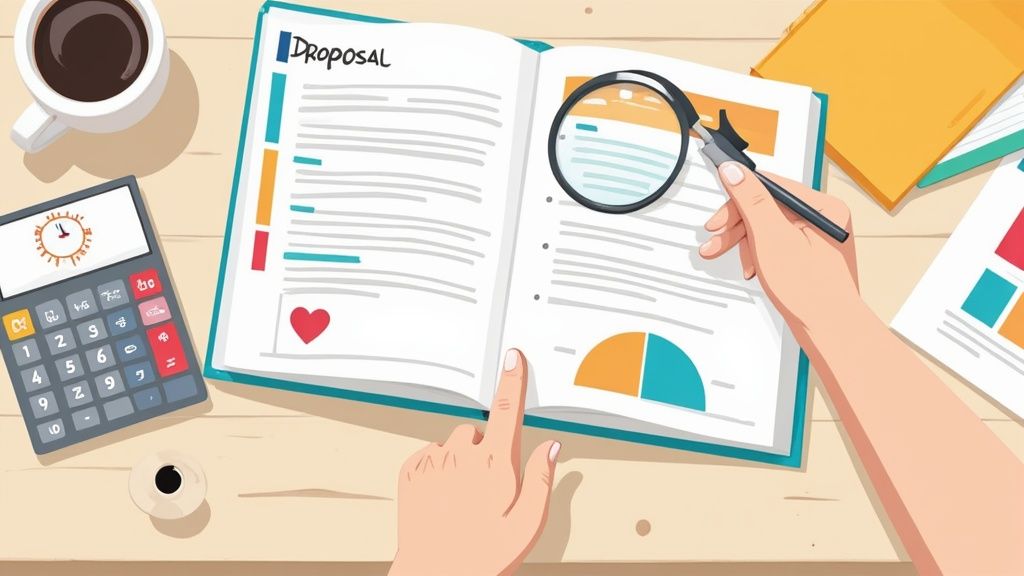
Learning how to write grants for a nonprofit is about much more than just filling out forms. It’s a strategic dance of research, relationship-building, and powerful storytelling. The real secret isn't just asking for money; it's about making a compelling case that perfectly aligns your mission with a funder’s vision. Success comes from a thoughtful plan, not a last-minute scramble.
Beyond the Basics of Grant Writing
Staring at a blank grant application is a feeling many of us in the nonprofit world know all too well. It can be incredibly intimidating, especially when you know how much your mission depends on securing those funds. Too often, organizations treat grant writing like a chore on a checklist, which is a fast track to a generic, forgettable proposal.
The reality is that successful grant writing is a dynamic process. It's part detective work, part networking, and part crafting a story that truly resonates.
Winning grants isn't a one-and-done deal; it's a cycle. Shifting your mindset this way helps you move from just being another applicant to becoming a genuine partner with foundations that believe in your work. It means you stop blasting out dozens of cookie-cutter applications and instead focus your energy where it has the best chance of paying off.
The Modern Grant Writing Cycle
I've found it helpful to break the whole process down into three core phases that flow into one another. First, you dig deep with meticulous research to find funders whose giving history and values genuinely match your work. Then, you connect with those organizations to start building a relationship before a proposal ever lands on their desk. Finally, you write a powerful story backed by solid data that makes your case undeniable.
This visual lays out the modern grant writing cycle, breaking it down into these three key stages: Research, Connect, and Story.
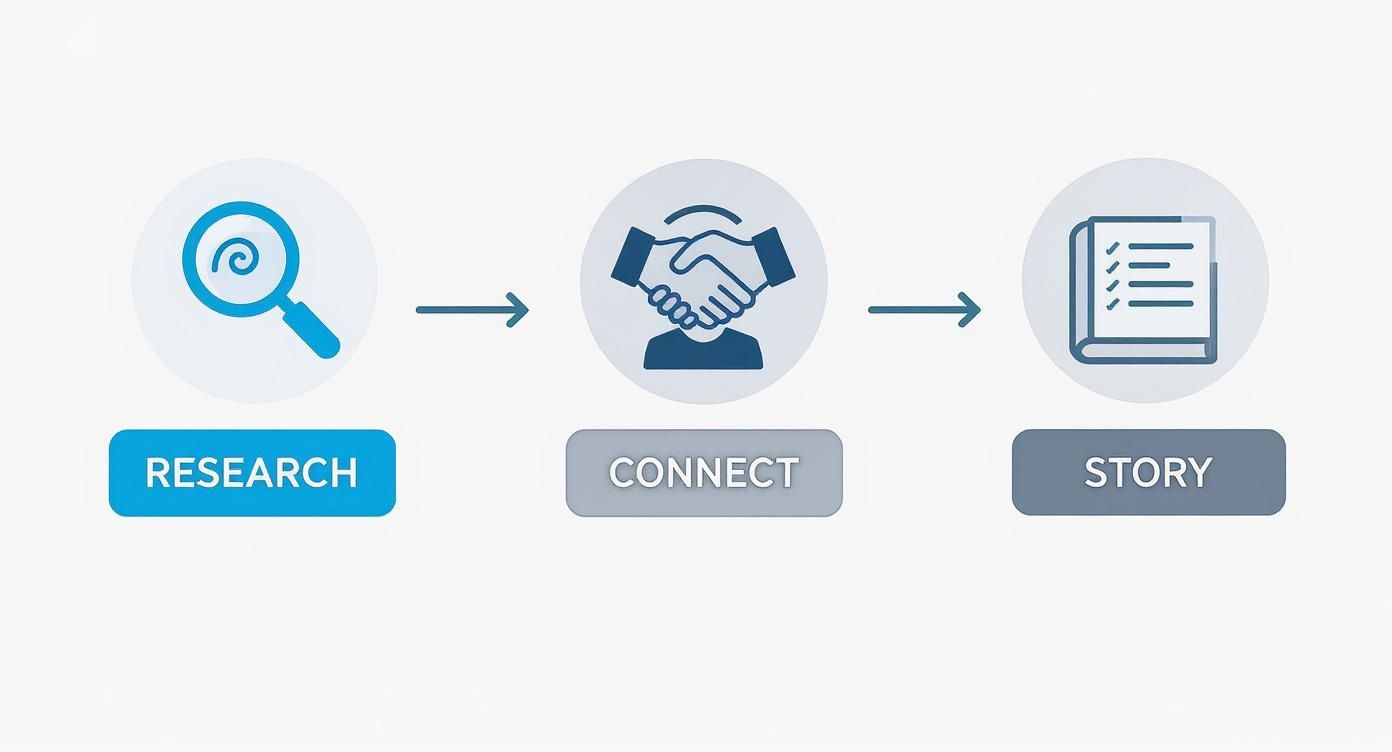
When you look at it this way, the process feels less like a mountain to climb and more like a strategic, manageable workflow. Every stage feeds the next, making sure your final proposal is targeted, personal, and ultimately, persuasive.
The most effective proposals feel less like an application and more like a conversation. They show you've done your homework, understand the funder's mission, and are inviting them to be part of a solution they care about.
Thinking in this cyclical way helps you organize your efforts and sidestep common mistakes. Instead of starting with a blank page, you begin with a deep understanding of your audience—and that's the bedrock of any winning proposal. New tools are also making this easier; you can learn more about how AI for grant writing is helping nonprofits speed up their research and drafting.
By adopting this strategic mindset, you won't just improve your funding success rate. You'll build lasting relationships that can sustain your organization for years. This guide will walk you through each phase, giving you actionable steps to confidently tackle the grant writing process and win the funding your nonprofit deserves.
Finding and Vetting the Right Funders
Let’s be honest: before you write a single word of your proposal, the most important work has already started. I’ve learned that successful grant writing means you have to be a detective first and a writer second. A shotgun approach—blasting the same generic proposal to a hundred funders—is a one-way ticket to burnout and a pile of rejections.
Real grant seeking is all about precision. It's about finding those few funding partners whose mission and values are a near-perfect reflection of your own. When you find that genuine alignment, the proposal practically writes itself because you're already speaking the same language.
Moving Beyond Basic Searches
A quick Google search for something like "grants for youth programs" will drown you in thousands of results, but most of them will be useless. To find the right fit, you have to dig deeper with specialized grant databases. These platforms are built to let you filter opportunities with incredible specificity.
One of the gold standards in our field is Candid’s Foundation Directory. It’s packed with detailed profiles on grantmakers, showing you everything from their giving history to their geographic focus. If you're working with a tighter budget, don't worry. A great starting point is exploring a curated list of opportunities. You can find some excellent options in our guide to the best free grant databases for nonprofits and begin your search without a hefty subscription fee.
No matter what tool you use, your goal is to build a highly targeted list of prospects. You’re not looking for 100 long shots; you're looking for 10-15 foundations that feel like a natural fit.
Becoming a Grant Detective
Once you have that shortlist, the real investigation begins. This is where you shift from a researcher to a strategist, vetting each potential funder to make sure your time is well-spent. Your mission is to truly understand what drives them, what they prefer, and how they operate.
Here are the key clues I always look for when investigating a potential funder:
- Giving History: Take a hard look at their past grantees. Who are they? Are they massive, national organizations or smaller, community-based ones like yours? If a foundation exclusively funds multi-million dollar hospital wings, your small after-school arts program is probably not a match, even if their mission statement mentions "youth development."
- Geographic Focus: This is a firm, non-negotiable filter. So many foundations restrict their giving to specific cities, states, or regions. Don't waste a second applying if you fall outside their designated area—it’s almost always an automatic disqualification.
- Average Grant Size: What’s their typical award amount? If you need $75,000 and their average grant is only $5,000, you’re misaligned. On the flip side, asking for $10,000 from a foundation that usually awards seven-figure grants might signal that your project doesn't have the scale they're looking for.
- Type of Support: Do they give money for general operating costs, or are they strictly focused on specific projects? Applying for unrestricted support from a foundation that only funds new buildings is a classic—and completely avoidable—mistake.
Vetting isn't just about finding funders who might say yes. It's about eliminating the ones who will almost certainly say no. This strategic disqualification saves your most valuable resource: your time.
Reading Between the Lines of a 990
A foundation’s Form 990 is a public tax document, and it’s an absolute goldmine of information. Think of it as the ultimate behind-the-scenes look at their financial world. You can often find these on a foundation's website or through databases like ProPublica's Nonprofit Explorer.
When you pull up a 990, you can see a complete list of every single organization they funded in a given year and the exact dollar amount of each grant. This data is so much more revealing than the broad, polished language on their website. It shows you what they actually do, not just what they say they do.
For example, a foundation’s website might say they support "environmental causes." But a quick look at their 990 could reveal that 90% of that funding went to large-scale water conservation initiatives. If your nonprofit focuses on community gardening, you'll know instantly that this isn't the right partner, even though you both technically fall under the "environmental" umbrella.
This is the kind of detailed homework that separates the grant pros from the hopeful amateurs. It shifts your approach from guesswork to genuine strategy, and that’s what ultimately gets your mission the funding it deserves.
Crafting a Compelling Proposal Narrative
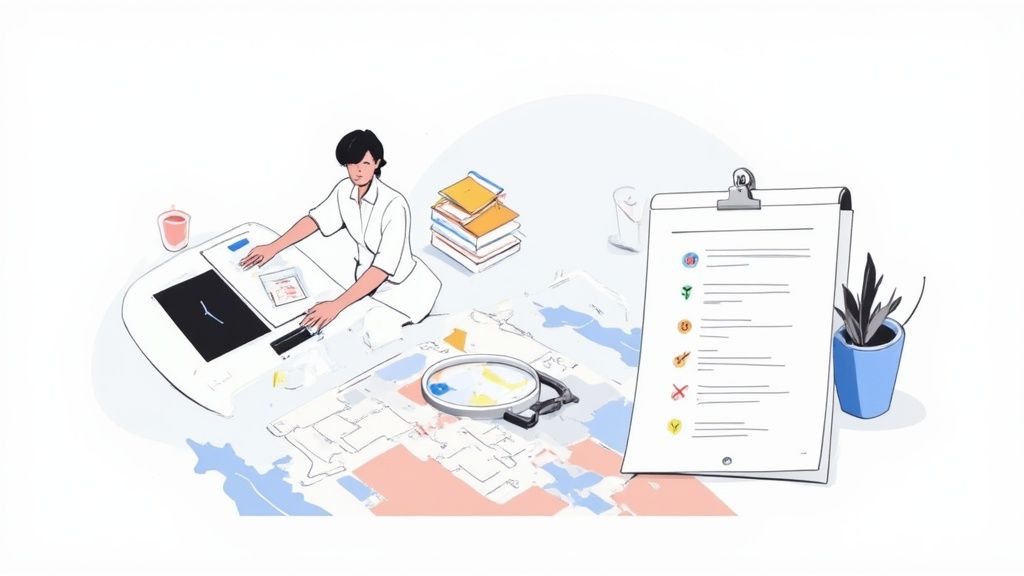
This is where the rubber meets the road. All that careful research you did now gets woven into a story that has to grab the reviewer and not let go. A winning grant proposal is so much more than a dry collection of facts; it’s a narrative that makes your mission feel real, connects with the funder’s own goals, and builds an undeniable case for why they should invest in you.
Think of it this way: you're the guide, and the grant reviewer is the person you're leading. Your job is to walk them from seeing a problem to truly believing in your solution. Each section of the proposal is a stop on that journey, building on the last to create a powerful, persuasive argument.
Building Urgency with a Strong Needs Statement
The needs statement—often called the problem statement—is the absolute heart of your proposal. If you don't get this right, nothing else matters. Its job is to create a genuine sense of urgency and convince the funder that a serious problem exists, and that your organization is the one that can fix it. Vague generalizations will get you nowhere; this section demands a powerful mix of cold, hard data and real human experience.
The magic happens when you blend statistics with a personal touch. For instance, you could open with a sobering city-wide statistic about third-grade literacy rates. But don't stop there. Immediately follow it with a short, anonymized story about a student who couldn't read a single page before your program, but who now reads bedtime stories to their younger siblings.
This one-two punch is incredibly effective:
- Data gives you credibility and shows the scale of the problem.
- Stories create an emotional hook, putting a human face on the numbers and making the issue feel immediate and tangible.
You want the reviewer to feel the weight of the problem. You want them to understand why this funding is critical right now. Without that fire, the rest of your proposal will feel flat.
A great needs statement doesn't just describe a problem; it makes the reader feel its impact. It’s the difference between saying "people are hungry" and painting a picture of a family choosing between paying for rent and buying groceries.
Remember to frame this problem within the funder’s world. Your earlier research on their priorities is your secret weapon here. Show them you understand what they care about and that your work directly tackles an issue at the core of their mission.
Defining Success with Clear Goals and Objectives
Okay, you’ve established the "why." Now you have to nail the "what" and "how." This is where you lay out your project's goals and objectives. People often use these terms interchangeably, but in grant writing, they have very specific and distinct jobs.
A goal is your big-picture, aspirational statement about the ultimate change you want to see. Think broad. For example: "To improve academic outcomes for at-risk youth in our community."
Objectives, on the other hand, are the specific, measurable, nuts-and-bolts actions you’ll take to get there. This is where the tried-and-true SMART framework is your best friend.
Laying things out this clearly shows the funder you’re not just pitching a nice idea—you have a concrete, actionable plan. It builds their confidence that their money will be used effectively to get real, tangible results.
Proving Your Credibility and Impact
You've defined the problem and laid out your brilliant plan. Now you have to prove your organization is the right one to pull it off. This comes down to two things: your track record and your plan for measuring success.
Your organizational background is where you build trust. In a few powerful sentences, tell your story—your history, mission, and biggest wins. Highlight past successes, especially any that are similar to the project you're proposing now. You're assuring the funder that you’re a stable, experienced organization that can be trusted with their investment.
Next, the evaluation plan answers the all-important question: "How will you know if it worked?" This is how you’ll measure your progress against the objectives you just set. It could involve pre- and post-program surveys, participant testing, or tracking specific data points over time. A solid evaluation plan screams accountability and shows a commitment to learning and improving, which funders absolutely love to see.
Speaking of success, it’s important to have realistic expectations. Competition is fierce, and for brand-new grant applications, success rates can hover around 10%. But here's the kicker: when nonprofits apply to funders who already know and trust them, those rates can go through the roof. In fact, proposals for established programs can see success rates as high as 90%. You can dig into more on grant writer success rates on Funding for Good.
This stat really drives home how important it is to build relationships, not just write great proposals. Sometimes, that process starts with a simple Letter of Inquiry (LOI) to test the waters. To see what a good one looks like, check out our guide with a sample grant letter of inquiry for a real-world example. Every touchpoint, from that first email to the final report, is a chance to build the trust that leads to long-term funding.
Telling Your Financial Story with a Clear Budget
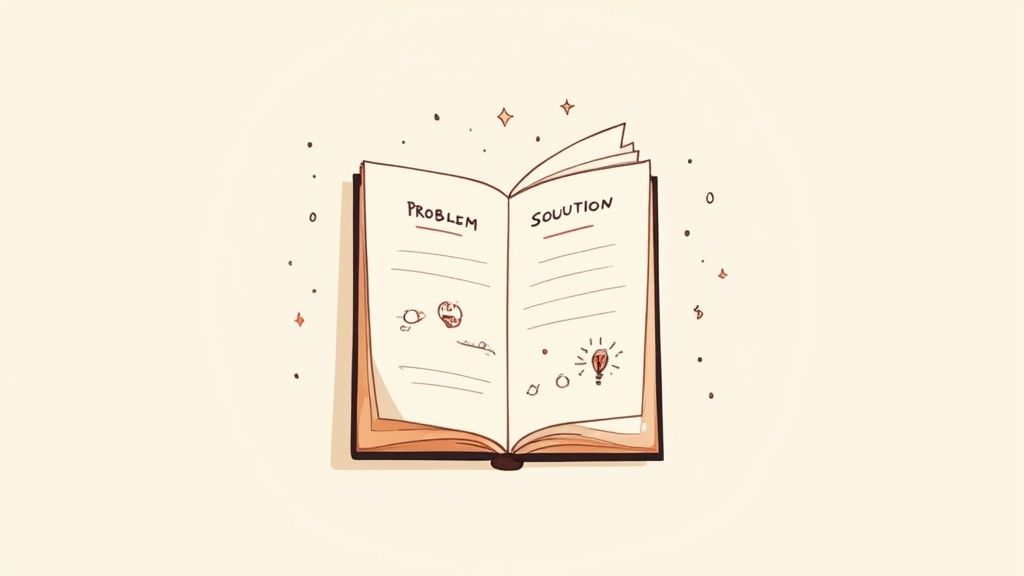
Let’s be honest, the budget section is where many grant writers start to sweat. It’s tempting to see it as just a spreadsheet to fill out, but that’s a huge missed opportunity. A truly great budget is the financial chapter of your project's story. Every single number on that page should be concrete proof of the narrative you’ve so carefully built.
Think of it this way: if your proposal narrative is the "why," the budget is the "how." It’s what turns your inspiring vision into a believable, down-to-earth plan. A funder needs to look at your budget and see a crystal-clear connection between their dollars and the outcomes you’ve promised.
Transparency is your best friend here. A detailed, well-justified budget builds incredible trust and proves you’ve done your homework.
Getting Your Costs Straight: Direct vs. Indirect
First things first, you need to sort your expenses into two buckets. Funders absolutely expect to see these separated, and getting it right shows you have a solid handle on your organization's finances.
Direct Costs are the expenses you can point to that are 100% for the project. For a community garden, this is the obvious stuff: seeds, soil, lumber for the garden beds, and the stipends you'll pay workshop facilitators. They exist because of this project.
Indirect Costs are what keep the lights on. Sometimes called overhead or administrative costs, these are the shared expenses essential for your organization to operate but not tied to a single project. Think rent for your office, utility bills, your Executive Director’s salary, and accounting services.
Heads up: many foundations put a cap on how much of their grant can cover indirect costs—it's often around 10-15%. Dig into their guidelines before you start building your budget to make sure you’re playing by their rules.
A rookie mistake is to try to hide administrative costs or shrink them down to an unrealistic number. Funders are savvy; they know it costs money to run a nonprofit. Being upfront about your indirect costs actually shows you're a well-managed organization with a plan for sustainability.
The Budget Narrative: Making Your Numbers Talk
Never assume your spreadsheet speaks for itself. The budget narrative is your chance to explain the logic behind the numbers. This is where you connect each line item back to the real-world activities of your project.
For example, don't just write: "Marketing Materials - $1,500."
Instead, your narrative should bring it to life: "$1,500 is requested for the design and printing of 5,000 bilingual flyers. These will be distributed at three local community centers to promote our free literacy workshops, reaching an estimated 7,500 residents."
See the difference? That level of detail proves two things: your costs are based on actual research, not a wild guess, and every dollar has a purpose. This is a vital skill when you're learning how to write grants for a nonprofit that gets a "yes."
Here’s a simplified look at how you might structure the budget itself, laying out the categories clearly.
Sample Project Budget Breakdown
This kind of clear, logical layout makes it easy for the reviewer to follow your thinking and see exactly where their funds would go.
Justify Every Penny—Realistically
The credibility of your entire proposal can rise or fall on the realism of your budget. Funders have seen it all, and they can spot inflated or, just as bad, dangerously underestimated costs a mile away.
Here’s how to ground your numbers in reality:
- Get Quotes: For any big-ticket item like equipment or a consultant, get at least two or three written quotes from vendors.
- Research Salaries: When budgeting for staff, use current data for similar roles in your city or region. You need to show you’re offering fair compensation.
- Showcase Community Support: Don't forget to include in-kind contributions—the value of donated goods or volunteer hours. This demonstrates that the community is already invested in your success.
A well-researched budget isn't just about numbers; it’s a powerful signal of your organization's competence. It tells the funder you'll be a responsible steward of their money, and that’s what ultimately separates a good proposal from a funded one.
Showing Your Impact with Hard Numbers and Smart Partnerships
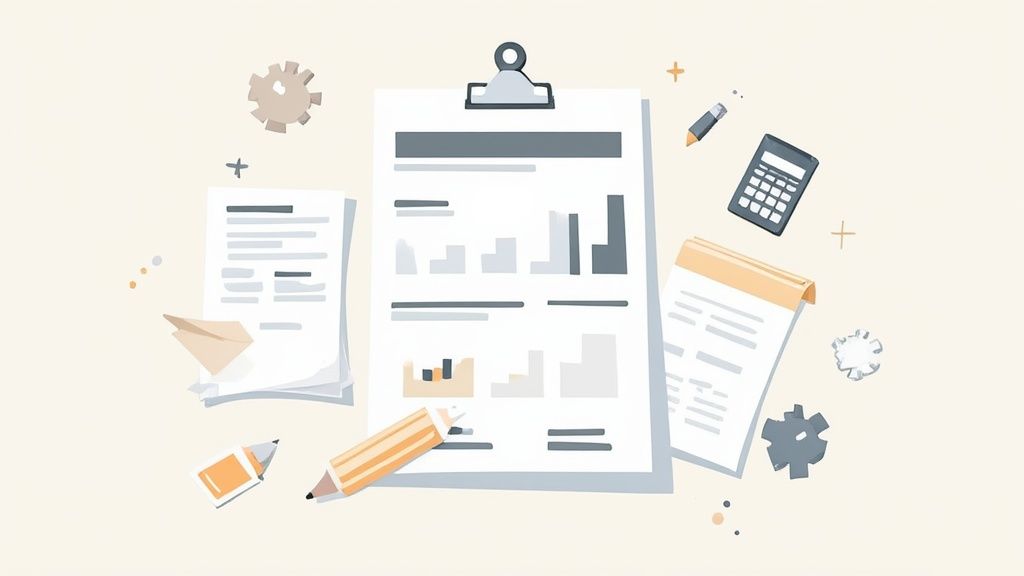
A great proposal doesn't just describe a problem; it proves your organization is the right one to solve it. Funders today are looking for two key things: solid evidence of your effectiveness and a collaborative spirit. They want to see that you’re not just well-intentioned but also accountable, ready to deliver real change, and savvy enough to work with others to make it happen.
Let's be blunt: data wins grants. A heartwarming story might get you a small individual donation, but foundations awarding significant funds need more. They need proof that their investment will pay off in tangible community benefits. This is where you shift from being a storyteller to a strategist, using key metrics to build an undeniable case for your work.
Build Powerful Alliances
No nonprofit is an island. Funders understand this, and they get excited when they see organizations teaming up to tackle bigger community issues. Forming strategic alliances with other groups isn't just good for the community—it's a potent grant-winning strategy. It shows a deeper level of planning and a real commitment to leveraging everyone's strengths.
Think about it: a food bank that partners with a local job-training center is offering a much more comprehensive solution to poverty than either could alone. This "collective impact" approach is incredibly appealing to funders because it signals efficiency, cuts down on duplicated services, and points to a more sustainable, coordinated effort.
When you write about these partnerships, get specific.
- Outline Clear Roles: Who is doing what? Detail the exact activities each partner will handle.
- Explain Shared Resources: How are you pooling resources? Mention shared staff time, facilities, or client referrals.
- Attach Letters of Support: This is non-negotiable. A formal letter of commitment from a partner provides concrete proof that the alliance is real and ready to go.
Weave Data Into Your Story
Using data well isn't about dumping a spreadsheet into your proposal. It's about picking a few high-impact numbers that prove your model works. Your goal is to draw a straight line from your activities to your outcomes, backed by solid metrics.
Instead of just saying your literacy program helps children, show that 85% of participants improved their reading scores by at least one grade level. That’s a number that sticks.
Grant writing has changed, and this data-driven approach is now front and center. Funders expect to see clear, measurable impact shown through thoughtful analytics and program metrics. As you can find in these effective grant writing strategies for 2025 on Brady Martz, proposals that provide this kind of evidence-based proof are far more likely to get funded.
A powerful data point tells a story in a single sentence. Choose metrics that are easy to grasp and directly relate to the problem you outlined earlier. This closes the loop for the funder, connecting the problem, your solution, and your proven results.
Always give your data context to make it meaningful. Don't just state a number; explain what it signifies. For example, if you served 500 meals last month, mention that this represents a 25% increase in demand. Suddenly, that simple stat becomes powerful evidence of a growing need, strengthening your entire proposal.
Common Grant Writing Questions Answered
Even after years in the grant writing trenches, questions still come up. You hit a wall on a tricky proposal, or you just need a quick gut check on the best way to handle something. It happens to everyone.
This section is all about tackling those common hurdles. Think of it as a chat with a seasoned pro, getting straight-to-the-point answers on everything from funder jargon to dealing with that dreaded rejection email.
How Should I Handle a Grant Rejection?
First things first: a rejection stings. Let yourself feel it for a minute, but then shift your mindset. The single worst thing you can do is file it away and forget it. A rejection is a free lesson, and you need to treat it that way.
After taking a breath, reach out to the program officer. A simple, polite email asking if they’d be willing to share any feedback is all it takes. You'd be amazed how many are happy to talk once the official decisions are out. They want to fund good work, and they often want to help you get there.
Never view a "no" as a closed door. It's often an invitation to a conversation that could lead to a "yes" down the road. A rejection is just data. Use it.
This conversation can be a goldmine. Maybe your budget narrative was a bit fuzzy, your outcomes weren't measurable enough, or the project just wasn't the right fit for their priorities this year. Every piece of feedback helps you strengthen not just your next application to them, but every proposal you write from here on out.
What Does "Capacity Building" Really Mean?
"Capacity building" is one of those classic grant-world phrases that sounds more complicated than it is. At its core, it’s all about funding that strengthens your organization from the inside out, making you more efficient, effective, and sustainable.
It's not money for your frontline programs. It’s an investment in the underlying infrastructure that makes those programs possible.
Here’s what that looks like in the real world:
- Technology Upgrades: Getting that grant to finally replace your ancient donor database or buy laptops that don't take ten minutes to boot up.
- Staff Training: Sending your team for professional development in fundraising, financial management, or communications.
- Strategic Planning: Hiring a facilitator to guide your board and staff through a much-needed strategic planning process.
- Board Development: Funding to help you recruit new board members with specific skills or to provide training for your current board.
These grants are highly competitive for a reason—they help you work smarter. They build a stronger foundation, which means every dollar you get for programs goes further and has a greater impact.
Should I Hire a Grant Writer or Do It In-House?
Ah, the classic debate. There's no single right answer here; it really boils down to your organization's specific situation—your budget, your team's current workload, and the skills you already have on board.
Hiring a professional freelance grant writer brings instant expertise to the table. These folks live and breathe grant writing. They know the landscape, write efficiently, and can jump right in. The downside is the cost, and they’ll never have the deep, day-to-day institutional knowledge of someone on your staff.
Keeping it in-house, on the other hand, builds your own team's skills and ensures every word of the proposal is dripping with authenticity. The challenge? It puts a massive time commitment on people who are probably already stretched thin.
I've seen many organizations succeed with a hybrid approach. Maybe you handle the foundation grants internally but hire a specialist for a complex federal application.
No matter which route you take, investing in strong grant writing pays off. The field isn't slowing down. In fact, professionals in some grant writing programs secured over $33 million in the first half of 2025 alone. You can dig into more of these grant writing trends and successes on Grant Writing & Funding. It just goes to show that building this skill set—whether by hiring or training—is one of the smartest investments a nonprofit can make.
Ready to supercharge your grant writing process? Fundsprout uses AI to help you find the perfect funders, craft winning proposals, and manage compliance with ease. Discover how our platform can save you time and help you secure the funding your mission deserves. Learn more at https://www.fundsprout.ai.
Try 14 days free
Get started with Fundsprout so you can focus on what really matters.
